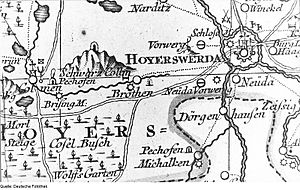Battle of Hoyerswerda facts for kids
Quick facts for kids Battle of Hoyerswerda |
|||||||
|---|---|---|---|---|---|---|---|
| Part of the Third Silesian War (Seven Years' War) | |||||||
 Contemporary map of Hoyerswerda. Battle site is marked. |
|||||||
|
|||||||
| Belligerents | |||||||
| Commanders and leaders | |||||||
| Prince Henry of Prussia | General Wehla | ||||||
| Strength | |||||||
| 3,000 | 3,000 | ||||||
| Casualties and losses | |||||||
| minimal | 600 dead 1,800 captured |
||||||
The Battle of Hoyerswerda was a small but important fight that happened on September 25, 1759. It was part of a bigger war called the Seven Years' War, specifically a part known as the Third Silesian War. This battle was fought between the armies of Prussia and Austria. Even though it was a small victory for Prussia, it was a big boost for their leader, Frederick the Great. His army had just lost a major battle at Kunersdorf the month before, so this win, along with another one at Korbitz, helped lift their spirits.
Before the Battle: Armies on the Move
In September 1759, several armies were moving around a region called Silesia. These included forces led by Frederick the Great and Prince Henry from Prussia. On the other side were armies led by Count Leopold Joseph von Daun from Austria and Pyotr Saltykov from Russia. They were all trying to outsmart each other.
Frederick the Great quickly moved his army across the Oder River. He managed to stop the Russian forces from taking important cities like Glogau (now Głogów) and Breslau (now Wrocław). However, he couldn't get the perfect position he wanted to start a big battle.
Meanwhile, the Austrian commander, Daun, wanted to follow up on his big win at Kunersdorf. He then heard that Austrian forces in Saxony had been badly beaten by a much smaller Prussian army. This made him even more determined to strike a major blow.
Daun marched his army to Görlitz and climbed to a high spot. From there, he could see the camp of Prince Henry, who was his closest enemy. Daun announced that he planned to attack Prince Henry's camp early the next morning, September 23.
Prince Henry's Secret March
Luckily for Prince Henry, he was already planning to leave the area. On the evening of Saturday, September 22, the Prussian soldiers quietly left their tents. They left behind only campfires and a small group of soldiers to make noise, pretending the camp was still full.
They first marched to Rothenburg in Upper Lusatia. They rested there for three hours. About twenty miles south, the Austrians charged forward and took over the empty Prussian camp.
Daun's scouts reported that the Prussian supplies were heading northeast towards Glogau. Daun thought it might be a trick and pulled back to Bautzen. But Prince Henry had a different plan. When he left Rothenburg, he headed west for eighteen miles to a village called Klitten in Saxony.
After another three-hour rest, Prince Henry's army marched quickly for twenty more miles. They were heading towards Hoyerswerda. There, an Imperial force of 3,000 men, led by General Wehla, was waiting, completely unaware of the approaching Prussians.
General Wehla was known for his bravery at the Siege of Dresden. He was placed at Hoyerswerda to help stop the Prussian armies in Saxony and Silesia from joining up. But recent events made this seem unlikely. Frederick the Great was busy fighting the Russians, and Prince Henry seemed to be heading east to join his brother. In fact, Daun had written to Wehla just a few days before, telling him there was no danger from the east.
The Surprise Attack
It must have been a huge shock when the Prussian advance guard, led by the Swiss General Lentulus, suddenly burst out of the woods. General Wehla quickly gathered his Croat regiment and set up his cannons. But a well-aimed Prussian cannon attack swept through his forces.
Within minutes, the Austrian soldiers were running away. General Wehla was captured, and six hundred of his men lay dead on the field. This defeat crushed Daun's hopes. He was now forced to march west into Saxony himself to strengthen his forces there. This left his Russian allies to face Frederick the Great alone.
The historian Thomas Carlyle later wrote about Prince Henry's night march. He called it "probably Prince Henri's cleverest feat." He said that this brilliant small operation surprised Daun and ruined his careful plans, effectively ending his campaign for that year.

